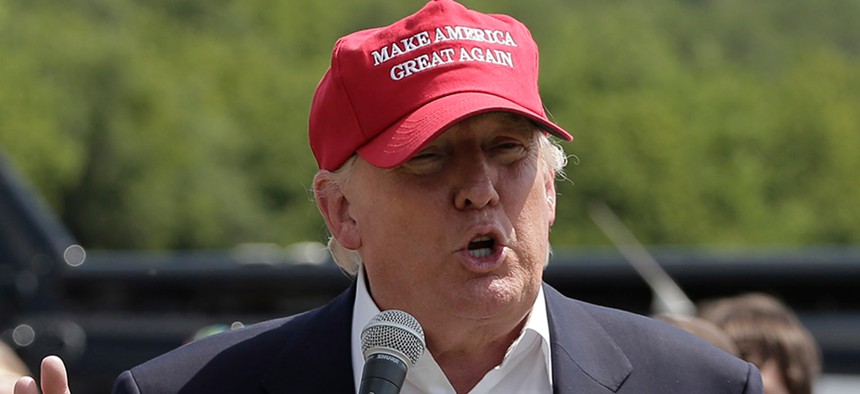
Charlie Riedel/AP
Here's the Cost of Donald Trump's Immigration Plan
If Trump needs illegal immigrants to go, it’s not going to be cheap.
It's not cheap to halt illegal immigration in America. And even a business mogul like Donald Trump may have missed the bottom line.
Since Donald Trump declared his intention to run for president, the 2016 contender has struck a nerve with the country's conservatives. And his message on immigration has been paramount to his allure.
Over the weekend, Trump took his rhetoric to paper and outlined his comprehensive immigration plan, which included erecting a border wall, strengthening internal enforcements like E-Verify, tripling the number of Immigration and Customs Enforcement officers, and requiring all immigrants caught at the border to be detained until they are removed from the country, not released and monitored.
And while Trump says his plan would boost the American economy, estimates for similar policies indicate it would come with a hefty price tag.
In his plan, Trump demands Mexico pay for his state-of-the-art border wall, but Mexican President Enrique Pena Nieto's spokesman told Bloomberg that the Mexican government has no intention of footing the bill. That leaves the cost of building up the border to the U.S., and an impenetrable wall comes at a multibillion-dollar price.
The U.S. already has in place more than 650 miles of border fencing. That project was estimated to have cost $2.4 billion in 2009 and will continue to cost billions to maintain. But Trump's plan calls for a better border fence. Assuming the existing fence is scrapped and replaced with one as secure as Israel's security barricade meant to deter terrorists, the cost of building a fence along all 1,989 miles of the southern border would come to more than $6 billion. National Journal once estimated it would cost $6.4 billion when all is said and done.
But the price tag of the border wall is pittance compared to the mass deportation Trump would like to see if he were president. While it was not listed explicitly in his online immigration plan, Trump told Meet the Press's Chuck Todd this past Sunday that immigrants in the country illegally would be sent back to their home countries.
"We're going to keep the families together, but they have to go," Trump said. "We either have a country or we don't have a country."
The explosive costs of mass deportation have often forced Republican presidential and congressional candidates to find another solution. Trump's position is far outside the mainstream of many other Republicans. There are several estimates out there on what it would cost to round up the roughly 11 million people who are residing in the U.S. without permission. The Center for American Progress, a liberal think tank, estimated in 2010 (when the illegal population was smaller) that it would take $200 billion to "arrest, detain, legally process and transport the undocumented population over a five year period." That did not include the $85 billion it tallied for keeping up with enforcement in the subsequent five years.
In 2011, the Houston Chronicle reported that ICE Deputy Director Kumar Kibble told members of Congress that it cost $5 billion to round up and deport 393,000 immigrants. That comes to a cost of approximately $12,722 per immigrant. If you had to deport 11 million people at that cost, the feds would be doling out about $140 billion.
Trump argues his plan would grow the economy and "end welfare abuse." Without millions of immigrants in the U.S., American workers, he says, would have better access to jobs.
"We need to control the admission of new low-earning workers in order to: help wages grow, get teenagers back to work, aid minorities' rise into the middle class, help schools and communities falling behind, and to ensure our immigrant members of the national family become part of the American dream," Trump said in his plan.
But stepping up enforcement on the border and internally will add up.
Trump wants to require that immigrants be detained until they are deported. It is estimated that detaining one immigrant costs $120 a day. Right now, some immigrants are allowed to live outside facilities for months until they are deported. Requiring every single immigrant to be detained would increase the cost of apprehensions and potentially require building more facilities to hold immigrants.
Another spendy piece of Trump's proposal is implementing internal enforcement measures like E-Verify, which helps employers validate a worker's immigration status. According to a 2013report by Alex Nowrasteh, an immigration policy analyst at the Cato Institute, E-Verify would cost $2.3 billion in the first 10 years.
When the Senate's so-called gang of eight released its immigration-reform bill in 2013, theCongressional Budget Office estimated the plan would cost $22 billion to implement. But, the plan—which enforced the border but also put some of the 11 million on a path to citizenship—reduced the deficit by $197 billion in the first 10 years.
It's unclear how much Trump's plan would reduce the deficit.
The biggest price tag of his plan, however, might not actually be possible to calculate. Immigration experts say that even immigrants living in the country illegally still contribute to the economy. A New York Times story from 2013 suggested that immigrants in the country illegally contributed $15 billion annually to Social Security. And the Department of Agriculture has long argued that deporting millions could have major effects on the U.S.'s agricultural economy, as it estimates that half of the country's farm workers over the last 15 years have been undocumented.
"You can quantify a lot of this. ... The part that is harder to quantify is the loss of these productive workers and energetic and innovative entrepreneurs," says Tamar Jacoby, the president and CEO of ImmigrationWorks USA, a pro-business immigration group. "A pause in immigration would put a huge dent in the American economy that is virtually impossible to quantify."







